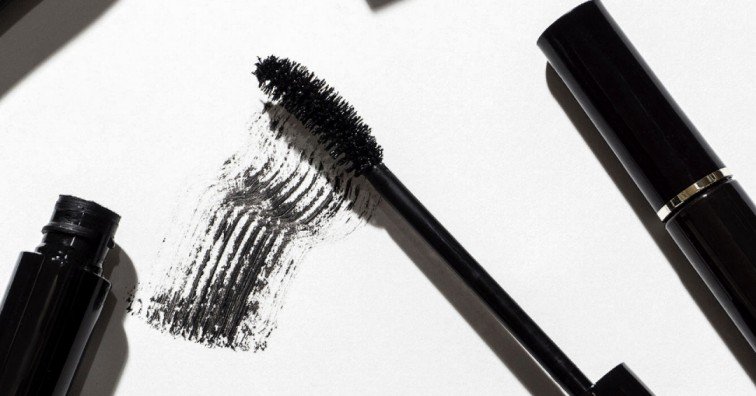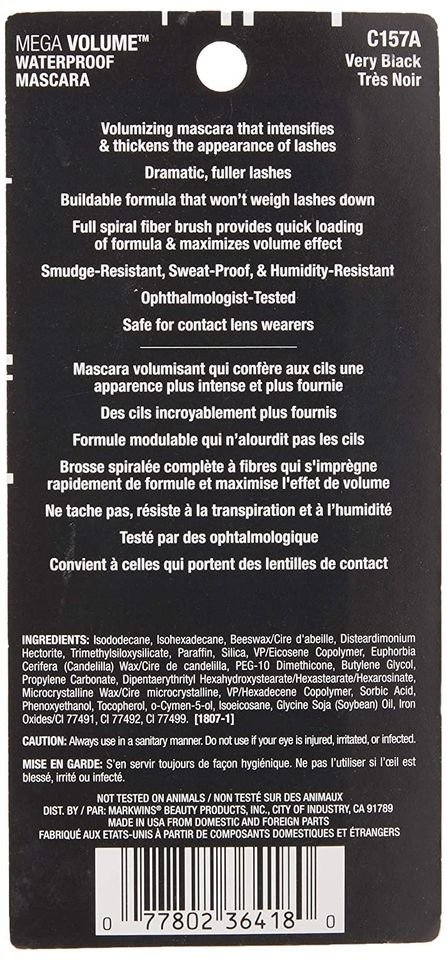For many people, putting on mascara is a daily ritual. It’s often a makeup must, but wouldn’t it be nice to know what this special tube contains?
If you look closely at the mascara package, you may see a long list of names that can’t be pronounced easily. It’s similar to you purchasing your body lotion and seeing a long list of names that are strange to you.
You probably have heard that there could be dangerous substances in your mascara tube.
You sure would want to know what really is in that blackish liquid. If your curiosity is as good as mine, I bet you want to find out.
What is The Composition of Mascara?

That mysterious-looking liquid in your mascara tube is made up of pigment, waxes, and oils to be able to coat your lashes and define their curl.
Mascaras today are not the same as mascaras decades back. The beauty industry has worked on ingredients to deliver a variety of mascaras that carry out different functions.
Generally, mascaras contain:
- A black pigment or colored pigment in the case of colored mascara.
- Waxes act as thickening ingredients to give it some consistency and texture. Waxes increase the thickness and volume of the product film on lashes.
- A polymer film to coat the lashes and keep them on. The polymer film used is usually water soluble and oil soluble polymers. The polymers help prevent the waxes from flaking off your lash.
- Preservatives to keep your mascara fresh and free from germs.
Truth is that mascara formulas contain more than just waxes and oils; there are emulsifiers, humectants, stabilizers, and dispersing agents.
Your mascara gets its color pigment from carbon black or iron oxide, and preservatives are used to extend the shelf life.
Mascara Composition: History and Myths
People did not begin wearing mascara in the 21st Century. You’d think this all-time makeup favorite popped from nowhere. For the longest time, possible mascara has been used to beautify lashes.
Ancient Egyptians are said to have used burnt ashes and kohl to darken their lashes, combining it with honey to make it sticky. Kohl has also been used to create vivid eyeliners and line water lines.
Tracing back mascara to a more recent time can be difficult as it is traced to two persons in the 1900s.
Some claim that in 1913, a French chemist named Eugene Rimmel was the first to produce a non-toxic mascara. While there is another sect that claims it was first produced by a beauty mogul Max Factor.
Either way, we have these men to thank for starting out with scientific-based formulas of mascaras that were considered safer. And since then, more scientists have worked on safer formulas that excluded the use of turpentine, aniline, and kohl, among many others.
Mascara Composition Myths
Mascara ingredients are labeled on the mascara pack. Still, it may look gibberish to you since it is difficult to recognize what is on the ingredient list.
But one of the highly misconceived ingredients is that mascaras contain bat feces. This sounds ridiculous but gained much attention back then.
So how do we know mascaras don’t contain bat feces, and why the misconception in the first place?
It is completely false, and this misunderstanding stems from language misunderstanding.
The idea of two similar cosmetic names- Guano and Guanine, further drove this myth.
In cosmetics, Guano is bat poop. And it is not a cosmetic ingredient itself.
But Guanine, on the other hand, is a Cosmetic Ingredient used as a colorant and an opacifying agent. This cosmetic ingredient – Guanine is derived from fish scales. Certain mascaras include an animal derivative.
Guanine is responsible for giving mascara that shiny, glossy appearance.
But instead of using Guanine, more mascara businesses are using a vegan derivative- bismuth oxychloride
What’s Inside These Types Of Mascara?
As much as we adore the drama of falsies and lash extensions, you don’t need makeup professional credentials or glue to get your ideal lashes. All you need is the perfect mascara. Of course, with so many various mascara formulations and wands available, that’s easier said than done.
These various mascara types can effectively carry out their mascara duties because of the wand and what’s inside the tube. Each mascara type may have different compositions to achieve its aim better.

Waterproof Mascara
This mascara type has recently become popular because of its special water-repelling function. Waterproof mascaras are like other mascaras but have a special ingredient Dimethicone Copolyol. This chemical is a silicone that functions as an emollient. It coats your lashes like a second skin and repels water molecules.
This type of mascara is great for rainy, teary or wet days! Waterproof mascara should always be removed properly before going to bed and used occasionally too.
Lengthening Mascara
We all purchase mascaras for the same aim that they would lengthen our lashes, making them appear longer than they are. A lengthening mascara gives you just that! With a mascara wand with bristles that properly curl and lengthen your lashes out, you also have a great blend of silicones in the formula that avoids mascara clumping. Commonly used lash lengthening fibers include Nylon 6 and Rayon. The formula is light and flake-free when coating each lash.
Volumizing Mascara
One of the most common ideas of purchasing mascara is that they make your lashes appear more voluminous and luscious! With volumizing mascaras, your lashes appear thicker! Volumizing mascara has a great blend of waxes that adds thickness. This gives it an excellent consistency to coat on more thickness to your lashes. Waxes like Nylon 6 and Rayon help build more volume to this mascara formula.
Curling Mascara
The Curl defining mascara is your go-to mascara for lash curl definition. Take the lash game to a whole new height with curling mascara.
Make your eyelash curler work harder by using a curling mascara that helps you fight gravity. This mascara wand lifts and separates your lashes for that ultimate curl effect. Curling mascara contains water and oil soluble polymer films that are fast drying,non-tacky and flexible films that contract when dry, curling and lifting your lash.
Mascara Tubing
Like traditional mascara, tubing mascara surrounds each lash with water-resistant, tube-like polymers rather than covering them with heavy layers of pigment. See them as a second skin for your lashes. It may sound strange, but these tubes truly enhance the appearance of your lashes. Additionally, tube mascara doesn’t budge, adds significant length and volume, lasts all day, and it’s incredibly simple to take off.
The innovative composition is meant to wrap around each individual lash strand like a “tube,” thickening and lengthening your lashes.
Mascara Fiber
Nothing was the same when fiber mascaras hit the cosmetics scene. Suddenly, you could take your standard recipe and increase length and volume using synthetic fibers as little as a half-millimeter. Double Stacked Mascara + Nylon Lash Fibers, packs a double punch. The Double Stacked Mascara prepares your lashes for the Nylon Lash Fibers and locks them in with a second layer.
Clear Mascara
Clear mascara is the ideal hype product for whatever cosmetic look you’re attempting to achieve. Clear mascara is the no-pigment mascara for that simple curled lash look. The transparent product allows your natural lash color to shine through while providing extra strength and direction to your brows and lashes. Looking to wow with shimmer? Clear mascara is the ideal foundation layer for your sparkly fantasies.
What Components Should You Be On The Lookout For?
This question has no one answer. In reality, it all boils down to your personal choices and demands.
Mascaras have other lash-boosting qualities, which are qualities to look out for while searching for the perfect mascara.
If you want a curl or additional volume, use a thicker formula.
Curling and volume-building mascaras have additional waxes like beeswax, paraffin, or carnauba wax in their formulas, which thicken the mascara.
For thicker-looking lashes, use mascara formulas with castor oil and jojoba oil.
Avoid mascara formulas with ingredients containing petroleum or propylene glycol since they might cause adverse reactions in certain people.
When it comes to avoiding mascara ingredients, it’s best to avoid the ingredient, Thimerosal. This preservative can induce conjunctivitis and eyelid dermatitis and should be avoided.
If you are looking for more conditioning mascaras, look for formulas with white tea, rose oil, aloe vera, castor oil, coconut oil, and jojoba oil extracts.
Make it a habit to discard your mascaras every 3 to 6 months. Using mascara for an extended time may mean that your mascara may host germs that can cause illness.
If throwing away a complete bottle of mascara after only a few months of usage seems wasteful, try purchasing smaller sample-size containers. They’re less expensive, and you’re more likely to finish them before they expire.
In Summary, look out for mascaras that are:
- Cruelty free
- Gluten free
- Paraben free
- Artificial fragrance free
- Hypollergenic.
Such brands offer you safer mascara formulas that are tested and trusted.
It is important to be able to track your mascara ingredients and avoid those ingredients that could be harmful. If looking out for harmful ingredients is too tasking for you, then making your own mascara is another option.
